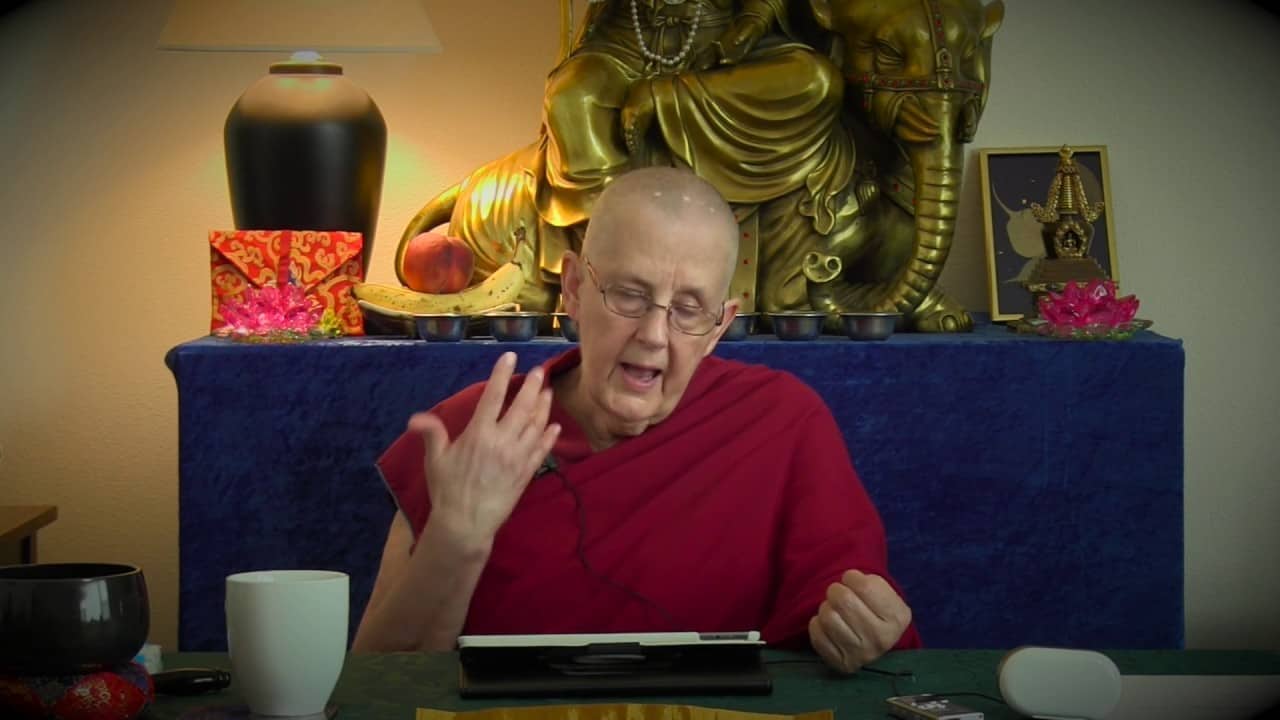The six far-reaching practices
The text turns to training the mind on the stages of the path of advanced level practitioners. Part of a series of teachings on the Gomchen Lamrim by Gomchen Ngawang Drakpa. Visit Gomchen Lamrim Study Guide for a full list of contemplation points for the series.
- Different ways to categorize the causes of Buddhahood
- How the six perfections relate to one another
- The purpose of practicing these far-reaching attitudes
- The four ways to gather disciples
Gomchen Lamrim 100: The Six Far-Reaching Practices (download)
Contemplation points
- Bodhicitta is beneficial at the beginning of the path because it gets us going, in the middle of the path because it keeps us going when things get tough or we get discouraged, and at the end of the path because it is what enables us to actually do the work of benefitting others. Go through each of these in your mind. Think of what it is like at each stage in the path. How does this mind of bodhicitta help you to progress on the path at each stage? Use specific examples from your own life or in the lives of others spiritual practitioners (Dharma friends and teachers).
- Consider how the method and wisdom sides of the path compliment each other on the bodhisattva path. Venerable Semkye said that before going into meditative equipoise on emptiness, the bodhisattvas generate bodhicitta, and when they come out of meditative equipoise, everything they do is informed by the wisdom cultivated in meditation. Imagine holding method and wisdom in your mind in this way. How might your life and your choices be different? Does thinking in this way inspire your mind? Why?
- The six far-reaching practices eliminate the many obstacles to our spiritual practice. Consider some:
- Eliminates obstacles to renunciation – We have little interest in looking past the happiness of this life and so we are not called towards renunciation. Bodhicitta helps us work on our attachment to our wealth, family, home, etc and see them as distractions unless we put them in the proper perspective. Examine how the things of this life are distractions for you. What is a proper way to view these things from the perspective of a spiritual practitioner? How do the six far-reaching practices eliminate this obstacle?
- Eliminates obstacles to benefitting others – It is easy to get angry or disheartened when others won’t cooperate with our efforts to help them. We have to be able to withstand hardship in this regard. How do the six far-reaching practices eliminate this obstacle?
- Eliminates the inclination to waste time in distraction – Concentration is what allows us to stay clear and focused in meditation; it allows us to cultivate wisdom of both the conventional and ultimate natures of all things. Distractions in meditation are a real hindrance to this. How do the six far-reaching practices eliminate this obstacle?
- If we want to attain awakening, we need a series of precious human lives. One of the causes for a precious human life is to practice the six-far reaching practices, which are generosity, ethical discipline, fortitude, joyous effort, concentration, and wisdom. Think about the results of each practice, why do these results come from cultivating those specific practices? Why are these results necessary to have to progress on the bodhisattva path?
- Training in generosity results in having what we need; we’re not struggling for requisites; we have all the conditions that allow us to train.
- Training in ethical conduct results in having a beautiful human body; long life.
- Training in fortitude results in having environments like the Abbey; having helpful companions; having others feel comfortable around you.
- Training in joyous effort results in accomplishing any goals you undertake.
- Training in concentration results in a stable, focused, clear mind; makes the mind ready and receptive to teachings.
- Training in wisdom results in understanding emptiness and attaining liberation and awakening.
- The six far-reaching practices are taught in a specific order: generosity, ethical discipline, fortitude, joyous effort, meditative stabilization, and wisdom. The preceding supports the next. Spend some time thinking about why this is the case. Try to make specific examples.
- The Buddha taught the four ways of gathering disciples to aid bodhisattvas in benefitting others. Even if you are not a teacher or bodhisattva now, these are all practices that you can cultivate in your life right now. Consider the importance of each. What can you do in your life right now to cultivate them?
- Be generous
- Speak kindly and teach the Dharma
- Encourage others in virtue
- Practice what you preach
Venerable Thubten Semkye
Ven. Semkye was the Abbey's first lay resident, coming to help Venerable Chodron with the gardens and land management in the spring of 2004. She became the Abbey's third nun in 2007 and received bhikshuni ordination in Taiwan in 2010. She met Venerable Chodron at the Dharma Friendship Foundation in Seattle in 1996. She took refuge in 1999. When the land was acquired for the Abbey in 2003, Ven. Semye coordinated volunteers for the initial move-in and early remodeling. A founder of Friends of Sravasti Abbey, she accepted the position of chairperson to provide the Four Requisites for the monastic community. Realizing that was a difficult task to do from 350 miles away, she moved to the Abbey in spring of 2004. Although she didn't originally see ordination in her future, after the 2006 Chenrezig retreat when she spent half of her meditation time reflecting on death and impermanence, Ven. Semkye realized that ordaining would be the wisest, most compassionate use of her life. View pictures of her ordination. Ven. Semkye draws on her extensive experience in landscaping and horticulture to manage the Abbey's forests and gardens. She oversees "Offering Volunteer Service Weekends" during which volunteers help with construction, gardening, and forest stewardship.


